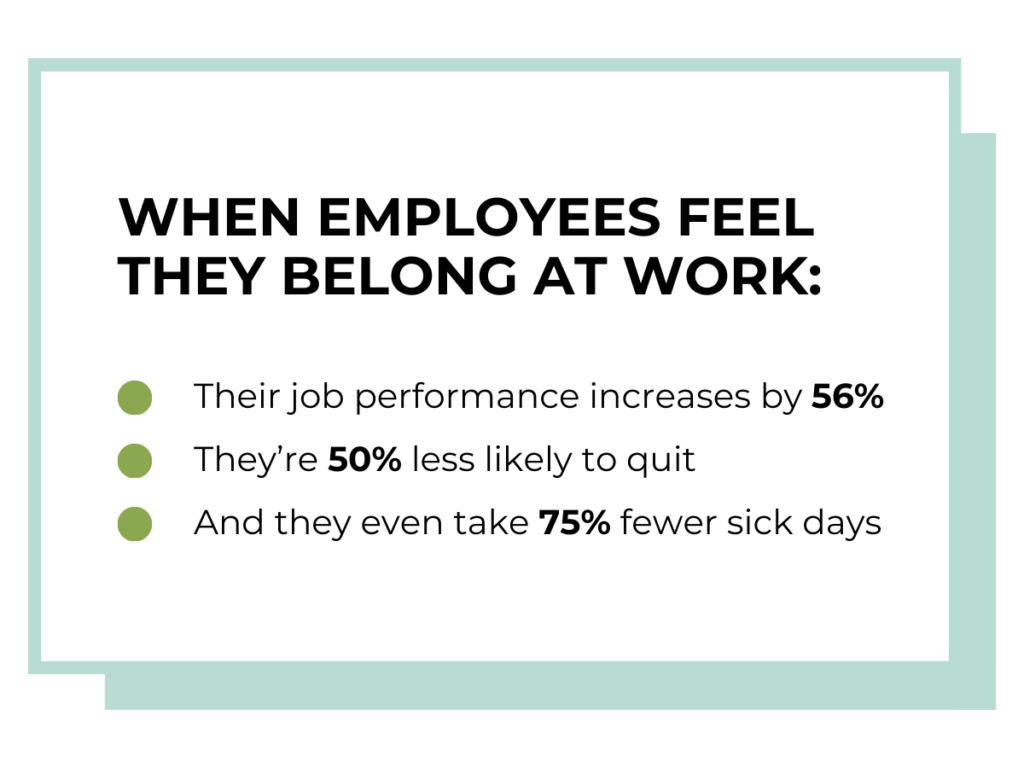The importance of a strong workplace culture is undeniable.
And, no, it’s not just about having cool office perks or the occasional team-building event. It’s about creating an environment that employees are excited to be a part of, where the spirit of community, camaraderie, and belonging extend beyond the office walls.
So, how can leaders make this happen? Whether through big initiatives or small everyday actions, the goal is the same: to build a workplace culture where everyone feels valued. Let’s jump in.
1. Promote a sense of belonging
We all know the warm, fuzzy feeling of belonging. Whether it’s being picked first in a schoolyard game, being part of a tight-knit group of friends, or even just getting a nod of acknowledgment for a job well done. That sense of belonging isn’t just good for our hearts—it’s essential for our brains, too!
Harvard Business Review shared some eye-opening stats about the power of belonging in the workplace:
So, how can leaders nurture this essential sense of belonging within their teams? Here are some strategies to consider:
- Recognize Achievements. During team meetings, give a shoutout to someone who’s done a great job. Trust us, a little praise goes a long way.
- Open Communication Channels. Encourage team members to share their thoughts, provide feedback, and ask questions. The goal is to foster a space where every voice is valued.
- Involve Employees in Decisions. When employees have a say in decisions that impact them, it promotes a sense of ownership and responsibility.
- Practice Inclusivity. Consistency matters. Use clear and inclusive language in communications, and ensure that opportunities for advancement are available to everyone.
2. Encourage healthy workplace habits
Being a role model in the workplace isn’t just about meeting deadlines; it’s about embodying habits that foster a positive and productive environment. Leaders have the unique opportunity to set the tone for their team by being champions of self-care. Responsibly using PTO and adhering to a regular work schedule not only rejuvenates employers, but it also empowers employees to embrace these healthy boundaries.
Leaders should also weave themselves into the fabric of the company’s culture. Their active participation in initiatives such as Employee Resource Groups or attending company events (virtual or in-person) sets a powerful example, inspiring their teams to engage and connect with the broader organization, too.

Collaboration is another cornerstone of a thriving work environment. When leaders initiate brainstorming sessions or solicit feedback, they do more than just compile ideas; they communicate to their team that every member’s viewpoint is valuable and essential to collective success.
Furthermore, strengthening the interpersonal connections within a team can lead to a more united and supportive atmosphere. Leaders can facilitate this by organizing informal “Meet and Greets,” coffee chats, or lunch outings to foster a sense of camaraderie and togetherness that extends beyond official work projects.
3. Plan team activities
Figuring out the ideal team activity or outing can often be a struggle for managers. To give you some inspiration, we’ve consulted with some of our top clients—who also happen to be your competitors—to learn what kinds of team-building activities they find most effective and universally appreciated.
Weekly Office Treats
Elevate a regular office day, like Tuesdays, with a consistent treat. “Popcorn Tuesdays,” for instance, can become a much-awaited staple, with fresh popcorn in the breakroom.

Friendly Competitions
A chili cook-off can spice up the office atmosphere. Beyond the taste test, it’s about the fun and light-hearted rivalry. The winner earns a prize or bragging rights!
Community Engagement
Rally the team for volunteer days. Participating in local community initiatives can be both fulfilling and a wonderful team-bonding experience.
Pet-Friendly Bonding
Host a “Bring Your Dog to Work Day” for pet-friendly team bonding. Just make sure that your office lease permits it and that all team members are comfortable and allergy-free.

Quarterly Celebrations
Choose a day every quarter for a special event, be it a catered lunch, an evening happy hour, or even an outing like a basketball game!
Celebratory Potlucks
Arrange team potluck gatherings, especially during festive seasons. Ideal times include the week leading up to Thanksgiving, throughout December, or on occasions like St. Patrick’s Day.
4. Foster a more respectful work environment
A cornerstone of an uplifting workplace culture is showing respect, not just in words but through actions. As leaders, recognizing and upholding a work-life balance sets the stage for a harmonious and productive environment.
Here are some practical ways you can achieve that:
- Consider Workloads Before Assigning Tasks. Before delegating time-consuming tasks, especially with short deadlines, touch base with your team. A simple inquiry like, “How’s your schedule looking today?” can prevent undue stress.
- Be Mindful of Focus Periods. If you notice a team member immersed in an important task or project, especially one that’s time-sensitive, avoid disrupting their flow for non-urgent matters.
- Streamline Meeting Invites. Involve only those whose insights are crucial to the meeting topic. It’s a gesture that respects your team’s time and ensures they’re not spread too thin.
- Clarify Impromptu Meetings. When there’s a need for a sudden meeting, a brief subject line or description can help set expectations, reducing potential anxiety or uncertainty for invitees.
- Honor the OOO Status. Whether an employee is on vacation, under the weather, or taking some personal time, it’s essential to let them truly be “away.” Reach out only if it’s absolutely necessary.
5. Prioritize consistent 1:1 meetings with your staff
Regular one-on-one meetings create a dedicated space for you and your employees to address comments, concerns, and questions—on a professional and personal level.

As a leader, it’s your responsibility to communicate your support and readiness to listen. While employees have the autonomy to decide what they wish to share, showing genuine interest and following up can help build lasting rapport and trust.
For example, if an employee mentions an urgent vet visit for their pet, ask them how they’re doing in your next one-on-one meeting. These seemingly small gestures accumulate over time, contributing to deeper. and more significant connections in the long run.
Final thoughts
Building a strong workplace culture isn’t a one-time task—it’s an ongoing journey shaped by thoughtful planning and consistent efforts. As we adapt and grow, let’s remain committed to creating an environment where everyone feels valued and included.
Related blogs you’ll enjoy
- 15 Effective Ways to Show Appreciation to Your Employees
- How Leaders Can Apply Empathy as Workers Return to the Office
- The Leader’s Guide to Effective Upskilling


